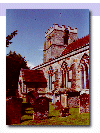![]()








![]()

|
WELLESBOURNE VILLAGE HISTORY |
|
|
The history of Wellesbourne and Walton has been well researched. Several books and pamphlets having been written by Rosalind and Peter Bolton on the subject of Wellesbourne and by Elizabeth Hamilton about Walton and the Mordaunt family. For details of these publications, see the page on this site listing BOOKS ABOUT WELLESBOURNE VILLAGE. For more information about the history of Wellesbourne and Walton join THE WELLESBOURNE VILLAGE SOCIETY AND HISTORY GROUP. They organise lectures and outings of local history interest; they also carry out research into the history of the villages, particularly in interviewing elderly residents who can remember what life was like before the many changes took place. Their memoirs have been recorded in three booklets, Wellesbourne and Walton at War, at Work, and at Play. For further details about the group or the history of the villages and the people who lived there please contact Iris Herwin 01789 840745, or follow the Group link above. You can read excerpts from Peter Johnson's fascinating book "Joe, The Story of a Warwickshire Countryman" here. The book is available to order from Fresh 'n' Fruity in the Precinct. Also of note are internet pages on Warwickshire Archaeology at http://www.warwickshire.gov.uk/general/arcindex.htm and the Warwickshire Record Office at http://www.warwickshire.gov.uk/general/rcindex.htm. Contained below is an abridged history of Wellesbourne and the surrounding area, organised as follows:
A probable 3500 year old Iron Age settlement in Walton was recently discovered during pipeline installation. It is our earliest evidence of human habitation. It is thought that there was some Roman habitation at Walton. In the 9th century AD Wellesbourne provided the setting for two important meetings of the Parliament of Mercia, and although the site has never been found, it is believed that there was a royal palace in the village at the centre of a royal estate. In medieval times there were two settlements in both villages, standing on either side of the Dene Brook which runs through the valley and joins the Avon at Charlecote. Using the names of prominent families of the time, they were called Wellesbourne Mountford, Wellesbourne Hastings, Walton Mauduit and Walton d'Eivile. Walton Mauduit stood on the site of the present day village of Walton and Walton d'Eivile, to the south of Walton Hall in a field still known as Old Town. It disappeared towards the end of the medieval period, perhaps as a result of the Black Death. Traces of the the ridge and furrow formation of the medieval open field system can still be seen at Walton, where enclosure came rather earlier than in Wellesbourne. From then onwards, right up up to the mid- twentieth century, the pattern of life remained much the same in the villages, with the surrounding land being farmed by yeoman farmers, many of them tenants of the Walton estate, and the 'labouring poor' living in the villages, with the shops in Wellesbourne providing for most of the needs of the inhabitants, and businesses such as the wheelwrights and blacksmiths, taking care of the farmers and their horses. In 1872 the farm labourer and Methodist lay preacher, Joseph Arch, called a meeting at the Stag's Head in Wellesbourne which was so well attended that it had to be held outside under the chestnut tree in the square. There the foundations were laid for a National Agricultural Labourers' Union which was able to bring about a gradual improvement in wages and working conditions.
After the second world war the age old pattern of life began to change. Higher wages, better educational opportunities, advanced technology particularly in the agricultural industry, and the ability of most families to own at least one motor car, radically altered the face of village life. The population multiplied, and new housing estates were built as well as a business park on the wartime airfield, and a shopping precinct and supermarket. At Walton, by contrast, there has been little new building and the land and much of the property is still owned by Sir Andrew Hamilton, the great-grandson of Sir Charles Mordaunt whose family first came to Walton in the sixteenth century, and his trustees. Walton Hall is now leased to a timeshare concern and the cottages in the village are let out to tenants, few of whom work on the land. |
||
![]()

![]()
